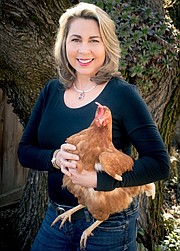Save seeds, save money!
Growing a garden is a great way to provide fresh, nutrient-rich vegetables, fruits and herbs for your family.
One way to make vegetable gardening a bit more economical is to save seed from plants to grow on the following year.
Seed saving is easy to do, even for beginners, and some of the most-popular vegetables, herbs and flowers in the garden are also the easiest to save seed from.
As the garden season gets underway, consider saving seed from peas, beans, tomatoes and peppers, or herbs such as dill, cilantro or parsley along with flowers like calendula, sweet peas and marigolds.
The key to successful seed saving is to collect from plants that are open-pollinated or heirlooms. These are plants that breed-true, which means the seeds will produce plants almost identical to the parent. All heirloom varieties are open-pollinated — they just have the distinction of being around for at least 50 years or more.
If you are growing hybrid varieties like early girl or sungold tomatoes or other popular vegetable hybrids, the seed is unlikely to produce a plant similar to the parent. It’s not to say that you can’t save hybrid seed, just know that the resulting vegetable will probably have very different characteristics than the original plant.
For best results, save seed from healthy plants and only select the best, fully ripened fruits or seed heads and, for plant diversity, gather seed from more than one plant. Allow the seed to dry completely, out of direct sunlight, before storing in a cool, dry location. When stored correctly, vegetable seed can last for years.
The two easiest vegetables to save seed from are peas and beans. Just allow a few of the pods to dry completely on the vine, harvest them, split them open and collect the seed. You can also pick pods when they are “leathery” and hang them to dry in a garage or shed.
Peppers seeds are also easy to save, just cut open the ripe pepper and scrape the seeds from the core or, for thin-walled peppers (most hot varieties), let the entire fruit dry and crack it open to collect the seed.
Keep in mind that “green” peppers are actually immature and their seeds are not viable. For seed saving purposes, peppers must be fully mature and will be red, yellow, orange, purple, or brown in color, depending on their variety.
Tomatoes take a little more effort to save seed due to the gelatinous covering on the seed that can inhibit germination. The best way to remove the jelly-like seed-coat covering is by fermentation.
The process is simple, albeit a little messy, and involves squeezing the tomato seeds and pulp into a glass jar, adding a bit of water and letting the mixture ferment for 48 to 72 hours.
The liquid is then drained off; seeds are rinsed clean and then allowed to dry completely before storing.
Many herbs like dill, chives, cilantro and parsley will happily reseed themselves if the flower heads are left to ripen. This can cause more seedling than you may want in the garden. To avoid self-seeding, cut mature seed heads and place them in a paper bag to dry completely.
Seeds from annual flowers, like calendula, sweet pea and marigolds can be saved and started indoors in early spring to be planted after the first frost.
Seed saving is easy, economical and fun to do and, best of all, it provides an endless supply to grow and share.
• • •
Candace Godwin is a Certified Idaho Master Gardener. The University of Idaho Extension, Kootenai County Master Gardener program is located in the UI Research Park, 958 S. Lochsa St., Post Falls. Learn about us at https://www.uidaho.edu/extension/county/kootenai/garden or on Facebook. Visit us in person or email us at kootenaimg@uidaho.edu, or call us at 208-292-2525. IMG services are free to the public.











